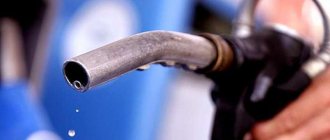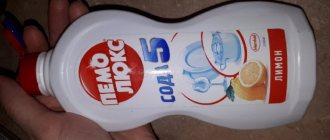The clothes of men who spend a lot of time in the garage often have not only an unpleasant pungent odor, but are also covered with a wide variety of stains. Most of the strong half of humanity practically live in their “second home”, and they are little concerned about how they look.
But their wives are puzzled by the question of how to wash diesel fuel, gasoline and other fuels and lubricants from clothes. Sometimes they cannot find a way to remove such complex contaminants as, for example, from diesel fuel.
Important: so that not a trace remains of the fuel stain, it is recommended to carry out cleaning measures immediately, without waiting for it to dry.
Removing gasoline stains
Before removing the smell of fuel from a product, it is necessary to remove the stain from it, which, most likely, was the cause of the smell.
- Dishwashing liquid. Dissolve half a glass of washing liquid in water and soak the soiled item. After three to four hours, take it out and squeeze it well. The larger and older the contamination, the longer the soaking should be. Afterwards, fill a basin with hot water, dissolve a tablespoon of soda and washing powder in it and wash the product by hand.
- Starch. To remove a stain using starch, mix 1 teaspoon of starch with a few drops of turpentine and ammonia. Rub the resulting mixture onto the stained area using a small brush. After processing, wash the item. This method will help remove traces of kerosene from the fabric.
- Iron. After washing with any washing powder, place a clean rag under the stain and iron with a hot iron. The heat will cause the fuel vapors to evaporate and not a trace will remain of it.
What not to do
To eliminate the unpleasant smell of fuel, people use dozens of different methods. Some of them can damage clothing or car upholstery. The advice of professionals will help prevent such a development of the situation.
It is prohibited to do the following:
- Use chlorine bleach. Such remedies will get rid of the stench, but will harm the person. As a result of the interaction between gasoline and chlorine, toxic fumes will begin to be released that can worsen your health.
- Wash clothes that smell of gasoline in a washing machine. If you make such a mistake, the smell of fuel will permeate the drum of the device. Because of this, all the clothes you wash will also develop an unpleasant odor.
- Wash the car interior or wash things with hot water. When using a heated liquid, the smell will only be more absorbed into the fibers of the fabric and it will be almost impossible to get rid of it.
You can get rid of the smell of gasoline on clothes if you follow all the rules for doing this work. In addition, the car owner needs to choose an effective remedy that will eliminate the problem and not harm things. If you successfully cope with this task, your wardrobe items will acquire their original appearance.
How not to remove gasoline stains
In the first place, do not try to get rid of gasoline by washing it in the washing machine, as it will be absorbed into the drum and can eat into other clothes in subsequent washes.
You should never use bleach; it reacts with gasoline, producing toxic fumes that will harm your body.
If your washing machine smells
How to remove the smell of gasoline from a washing machine if it is soaked through with it? Some housewives are sure that nothing can be done about it, but in fact there are ways to eliminate the aroma.
The most common means of removing petroleum odors from a washing machine is baking soda . Just pour 200 grams of soda into the powder compartment and run any wash cycle with a temperature below 30 degrees. Temperature is very important, because if the water is hot, the smell of gasoline will only intensify. There is no need to load things into the car.
How to remove gasoline from clothes
The method of ventilating things is only suitable if a small amount of fuel has come into contact with them. The process will take a very long time: from several days to several weeks.
To speed up the process, you can do the following:
- hang things in the open air, preferably in a draft;
- create a directed air flow, for example, point a fan at the problem area;
- place the product in frosty air.
If you want to hang things up to ventilate the room, make sure that no one around you is allergic to gasoline or its smell. Do not forget that the fumes are poisonous and can cause headaches and dizziness; it is better not to risk it and place the item outside the living space.
Useful tips
Before you start removing diesel fuel from clothes, you need to remember some nuances:
- It will be easier to wash off the fuel if it has not yet ingrained itself into the fabric, so you must begin removing the stain immediately after detecting the stain;
- You need to wash off diesel fuel correctly: treating the dirt from the edges and gradually moving towards the center of the stain;
- When removing this type of pollution, it is important to remember your own safety: diesel fuel is a flammable substance, so work should not be carried out near an open fire;
- If all the methods for removing diesel fuel have been used, but no result has been achieved, you can use an old but proven method - ironing the item
How to remove the smell of gasoline
- Washing powder. Wash the item in a basin with a powder that has a pronounced fragrance. Take the product out into the fresh air to dry and ventilate.
- Soda. Prepare a solution of soda at the rate of 4 tablespoons per glass of water and distribute the resulting mixture onto the contaminated area. After an hour, wash the item in your usual way.
- Ammonia. Using a cotton pad or piece of soft cloth, apply a small amount of ammonia to the problem area and wash with any detergent.
- Fabric deodorants. The stores offer a wide selection of products to combat unpleasant odors. It is possible that these deodorants will help solve the problem.
Special means
Don’t know how to wash gasoline from clothes using improvised means? It couldn't be easier. The first folk recipe that will come to the rescue is dishwashing liquid, which must be applied to the stained area or soaked in water with the addition of a product. We recommend using a good quality composition that can quickly cope with contamination.
Soak the item of clothing for a couple of hours, then wash in high temperature water with the addition of washing powder. Machine wash is also a good option. The method is extremely effective if the contamination is treated immediately after detection - after drying, it is quite difficult to clean gasoline traces.
Another recipe involves using chalk. Crush a small amount of chalk and pour it onto the contaminated area, leaving it for a couple of hours. Then shake the chalk off your clothes. If the remedy turns out to be ineffective, the procedure can be repeated a couple of times. If you don't have chalk on hand, use table salt.
After cleaning, wash the item of clothing as usual. To combat dirt, it is good to use a special soap called “Antipyatin”, which can easily be found in the store on the shelf with household chemicals. Simply lather any petrol traces you find, leave for a while, then wash the product.
To get rid of the stain, clothes must be washed after using special products.
If you do not have free time and (or) the opportunity to cope with the task yourself, you can always use the services of dry cleaners. For a fairly modest fee, they can quickly and without consequences eliminate both unpleasant and greasy stains. This is especially true if you spilled liquid on a product made of genuine leather, which is very susceptible to chemical reagents.
How to get rid of the smell of gasoline on clothes using folk remedies
- Lemon juice. Add lemon juice to water in a ratio of 1:3, washing powder and wash as usual.
- Wrap the damaged item in newspaper, put it in a plastic bag and leave it for a week. Porous paper will absorb fuel vapors and all that remains is to ventilate the clothes in a draft.
- Among other things, you can try rubbing the problem area with laundry soap, rinsing and washing.
It is important to remember that it is worth turning to traditional methods when other methods, washing and airing, have not coped with the task.
Will washing help?
Classic washing using washing powder will not help cope with the problem . With its help, you will only be able to get rid of a slight odor that has become saturated with things during a short stay near odorous substances.
If gasoline or diesel fuel gets on the fabric, or a person has worked with it for a long time, you will have to use more active substances than washing powder.
You need to focus your efforts on removing grease stains. If it remains on clothes, then the obsessive smell will endlessly haunt its owner.
Local cleaning methods
Any petroleum refining product can leave dense stains that are difficult to remove. They are removed in the same way as greasy stains.
In the first minutes after the oil product gets on the fabric, you should sprinkle the resulting stain with salt, then clean it with a brush, and repeat the procedure. Salt prevents the oily substance from penetrating deeper, and it is easier to wash items treated with sodium chloride.
Do the same when using talc or crushed chalk. It is important to treat the area around the stain as well . Afterwards the item is washed without much effort.
Gasoline stains can also be treated with a solvent. It is applied to the entire stain and the surrounding area, left for half an hour, then washed off.
Lemon: juice or acid
- Apply a little lemon juice or citric acid solution to the contaminated area.
- Wash the item.
- Repeat treatment if necessary.
Before use, drip lemon juice onto an inconspicuous area. Make sure that the paint on the product is durable, as citric acid tends to bleach the fabric.
Lemon and citric acid will remove gasoline and whiten fabric.
General recommendations
- Do not delay washing - as soon as you notice a diesel stain on your clothes, remove it and use a paper towel or napkin to remove the excess substance.
- Do not put soiled items in the laundry basket to avoid staining others.
- Also, do not wash it with other laundry.
- Carefully study the composition of the fabric and the manufacturer's recommendations for caring for the item. If washing is prohibited, you should immediately take it to the dry cleaner without trying to clean it yourself.
- Place a board wrapped in a towel or paper napkins folded in several layers under the fabric.
- The stain should not be rubbed in different directions, as this can increase the area of the contaminated surface. You should make careful movements from the edge to the center.
Heat treatment
This is the least expensive method, but it will require a well-heated iron and ironing board. Heat treatment can be carried out on a flat surface that is resistant to high temperatures.
- Wash the stained area of clothing by hand with laundry detergent.
- Place any clean fabric on the ironing board.
- Place the contaminated item on top.
- Iron the problem area with a hot iron until the gasoline evaporates. The stain should disappear after this treatment.
Exposure to high temperatures will cause the gasoline stain to evaporate.
Odorous mixture
- Measure out equal parts of potato starch, ammonia and turpentine.
- Mix the ingredients carefully.
- Apply the mixture to the contaminated area and scrub with a brush. It is recommended to take an unnecessary toothbrush.
- Wash with regular powder
- Evaluate the effectiveness of cleaning and, if necessary, clean with the mixture again to remove the stains completely.
- Yellowish traces remaining after treatment are removed with a weak solution of hydrogen peroxide.
Potato starch with ammonia and turpentine is applied to the stain











